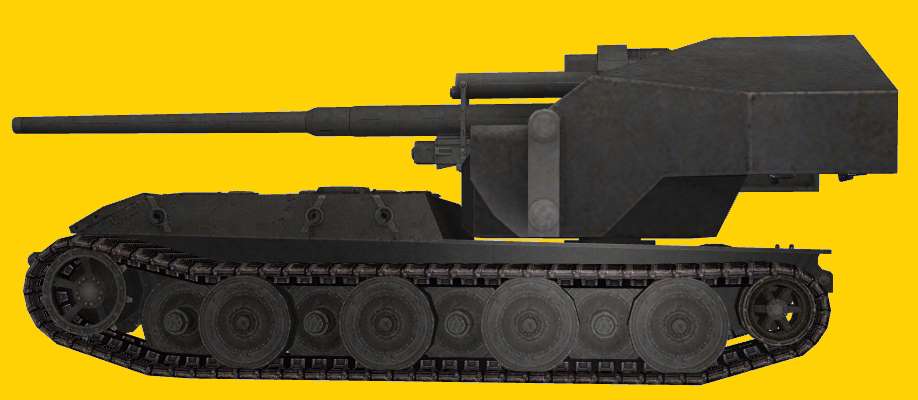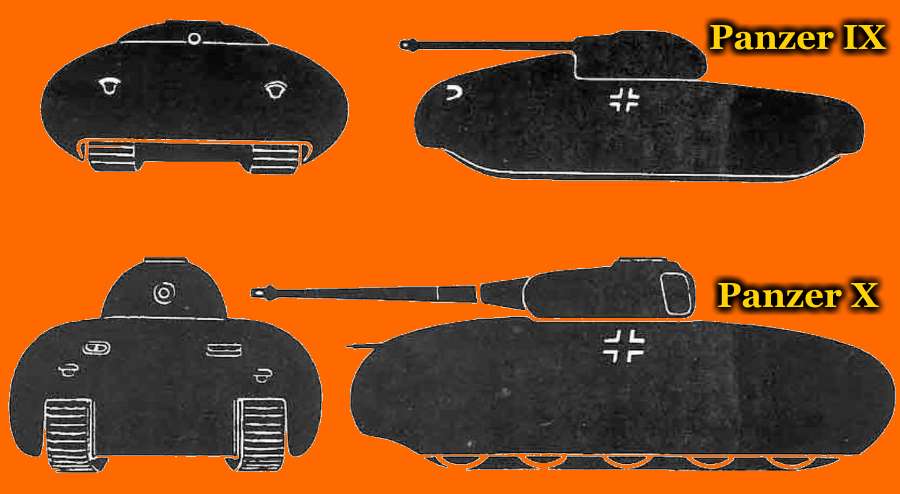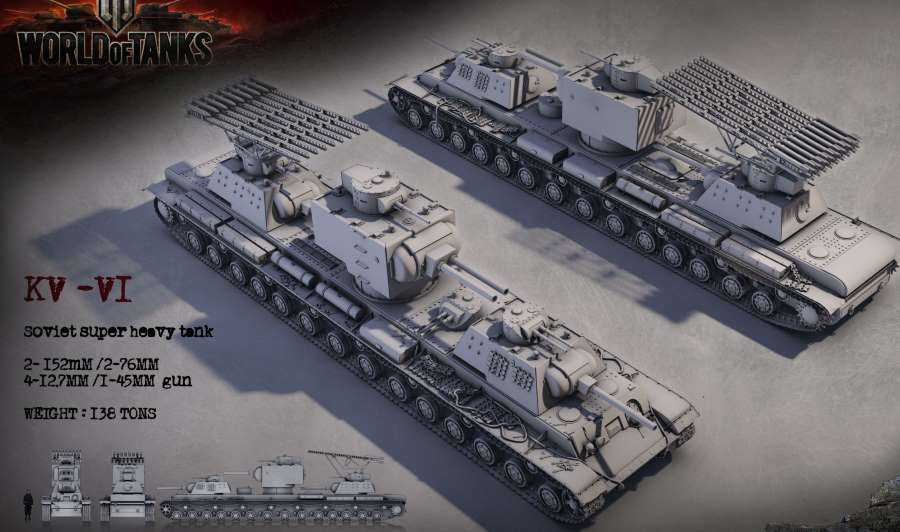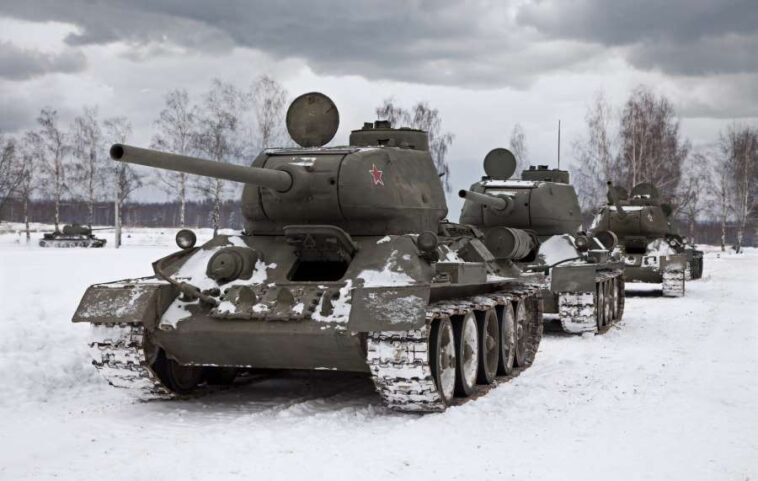In times of peace, what we nowadays call ‘fake news’ is oft-considered a great nuisance, arguably even a threat to democracy itself. In times of war, its great power to sway hearts and minds is only magnified. No war before – and one might argue no war since – has made this more apparent than the Second World War, with both the Allies and the Axis churning out record levels of propaganda to boost morale for their own side and demoralize the other. Such propaganda sometimes extended into tanks and tank production, the armored fighting vehicles garnering legendary status among soldiers and war enthusiasts both contemporary and modern. To this day, the argument over whether one Tiger equaled ten Shermans continues to rage throughout the historical community.
Here are some of the more notable fabrications brought forth from the rumor mills that have tricked their readers into believing that they existed.
1: KV-2-2-2 Heavy Tank

As a German tanker, what could possibly be more frightening to face on the battlefield than a Soviet Kliment Voroshilov heavy tank? After all, these fearsome war machines proved to be a thorn in the side of the German invaders during the initial phase of Operation Barbarossa. Their thick armour could laugh off any contemporary anti-tank weapon fielded by the Wehrmacht except for the 88-millimetre anti-aircraft gun. So effective were they at holding the line, that an entire German panzer division was held up by one single KV-2, which was only destroyed after it ran out of ammunition, allowing for an 88mm gun to be towed right up to it and fired into its backside.
Now imagine a similar scenario, but with three 152-millimetre howitzers attached to a triple stack of turrets, looming over the battlefield like a huge steel siege tower. Upon seeing a photograph of this devastating war machine on Google, one might be forgiven for thinking that the mere sight of a KV-2-2-2 haunted the nightmares of many a Wehrmacht tanker. Except they didn’t – because the image in question was photoshopped as an Internet meme. Where and how exactly the meme started is unclear. However, it has persisted in forum discussions and featured in the videos of several YouTube gamer channels, such as PhlyDaily and BaronVonGamez, where one such nickname for it is ‘Tower of Stalin’.
2: Waffenträger auf E-100

Another war machine borne from the Internet age. Fighting a self-propelled anti-aircraft gun system armed with a rapid-firing 128-millimetre automatic cannon would be a daunting prospect – any veteran can attest to that. That is, any veteran of computer game World of Tanks, where the Waffenträger (Gun Carrier) auf E-100 made an appearance as a top-tier tank destroyer. It came to be among the most feared and loathed tanks of WoT’s endgame as a highly effective glass cannon, able to blast even Cold War main battle tanks like the T-62 and the M60 Patton into paste without breaking a sweat.
An alleged proposal to mount a high-caliber AA gun onto the Panzerkampfwagen E-100 super-heavy tank prototype, the dreaded ‘waffle’ was revealed to have been made up specifically for the game. It was removed from the PC version of World of Tanks in 2016, where its place at the peak of the German tech tree was replaced by the Grille 15, a (real) plan to mount a large-caliber gun onto the Panther tank chassis. As of the writing of this article, it still remains on the game’s console port, however, as well as in the imaginations of many a WW2 game enthusiast – with downloadable mods featuring the WT auf E-100 abound.
3: Panzer IX

The third armored terror on this list comes not from the great spindles of the world wide web, but from the war itself. Specifically, the Wehrmacht’s biweekly print magazine Signal made mention of two new types of super-heavy tank being developed – the Panzer IX and its successor, the Panzer X. After hearing of proposals for successors to the Tiger tanks, in the form of the cancelled Panzer VII Löwe (Lion) and the even heavier Panzer VIII Maus (Mouse), the notion of no less than two new models would have certainly alarmed their enemies and boosted morale for the troops on the front who read the magazine.
As it happens, this is exactly why the Panzer IX and X were fabricated by Signal to begin with. A silhouette conceptual drawing of the alleged Panzer IX was printed in a late-war edition of the magazine for the sole purpose of deceiving Allied intelligence. No actual designs for such a ninth panzer have ever been found – or at least none that were even close to the Signal sketches.
4: KV-6 Land Battleship

Although at first glance this fabrication looks like it was pulled straight out of the Command & Conquer: Red Alert video games, the KV-6 is actually one of the more believable designs on this list if one reads the ‘history’ behind it. In the interwar period, multi-turreted ‘land battleships’ were something of a craze for tank engineers all across the world. This particular craze produced such war machines as the German Neubaufahrzeug prototypes, the British Independent and the Japanese O-I. The Soviet Union itself was guilty of building several of their own, such as the T-35 and the SMK, before the war broke out.
Given this information, it doesn’t seem like too much of a stretch for the Red Army to have ‘improved’ upon the designs. Gun turrets armed with cannons chambered from 45mm to 152mm plastered all over a lengthened KV hull and a Katyusha multi-launch rocket battery at the back for good measure sounds right up Josef Stalin’s street. Despite that, the KV-6 is, like the above-mentioned Tower of Stalin, yet another fabrication romanticized by the Internet. The ‘original’ KV-6 was actually a composite of several plastic scale models fused together by hobbyist Brian Fowler in 1995. Photos of the model were posted on tank modelling website Track-Link in 1997, complete with a fake history for ‘Stalin’s Orchestra’, and its popularity has skyrocketed since.
5: Jagdpanzer E-100 ‘Krokodil’
Out of all the fabricated tanks of WW2 on this list and elsewhere, the Jagdpanzer E-100 Krokodil is arguably one of the most famous. It first appeared in a 2007 issue of French historical magazine Batailles & Blindés, with depictions and sketches for it drawn up by artist Hubert Cance, and has been circulating on the Internet ever since. There are even plastic scale models sold of the fake tank by scale modelling company Trumpeter, complete with claims that a few prototypes had been built by the end of the war. (For the record, only one E-100 chassis was ever built, and it was captured by the British.)
There is a smattering of truth towards the Krokodil’s prevalence, however. During the development of the Entwicklung (E) series and the Panzer VIII Maus, Hitler commissioned the construction of a tank destroyer built upon the chassis. The actual proposal, dubbed Sturmgeschütz E-100, would have positioned the casemate in the middle or at the rear (as opposed to the front, as on the Krokodil) so that the chassis could support the weight of its massive 170-millimetre gun and its thick armour. An accurate representation of what the real tank would have looked like, if it had ever rolled off the production lines, can be found in World of Tanks as the Jagdpanzer E-100.
So there we have it. If nothing else, the sheer popularity of these fake tanks in discussion circles all over should be a warning. It is oft-said of history that it is written by the winners of wars, who hold total control over information. Particularly in this day and age where fake news could potentially undermine the media industry as a whole, it is nothing short of a duty for any reader to ensure that their sources are correct and to remain vigilant for forgeries. This goes triply for the historians who are responsible for the delivery of messages, information and above all lessons from our troubled past to those in the beleaguered present and the uncertain future.




Comments
0 comments